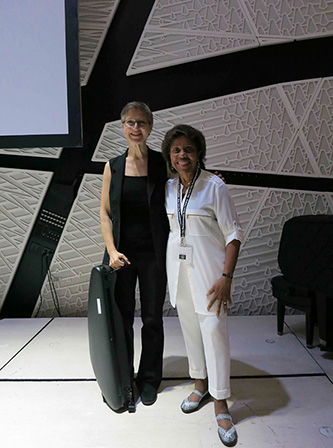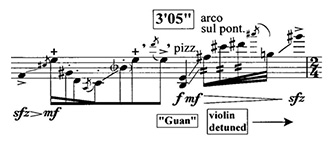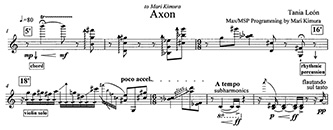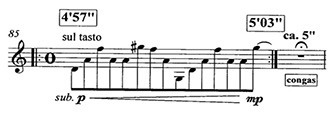American Music Review
Vol. LI, Issue 1, Fall 2021
By Maja Cerar
When Tania León set out to compose Axon for violin and interactive computer in 2002, she immediately envisioned the work on two levels.1 The technically demanding violin part, notated in the style of modernist concert music, represents the first level. The second level is an electronics part containing audio samples from recordings of previous compositions by León. Nearly all the samples are from Batéy, a collaborative work for vocal ensemble and percussion by León and Michel Camilo (1989), and at least one is from A La Par for piano and percussion (1986).2
When I asked León in an interview about the relationship between the two levels, she described it as follows: “[When] I wrote Axon, I knew [Batéy] inside out. As I created […] the violin piece, I knew instinctually [sic] where [Batéy] will be able to converse with that piece [Axon]. […] I went through [Axon] like magic, and I knew where each one of [the sound samples] were going to be placed. [...] I worked with both elements: the intellectual and the intuitional. I don’t feel so great when I don’t allow my intuition to tell me what to do.”3
The score to Axon, however, does not mention Batéy, A La Par, or any relationship among the pieces.4 The one-paragraph program note in the score states that in Axon, “pulses and impulses travel and refract away from each other thus creating a sound world of new spectral motivic sound images.”5 The audio samples from Batéy and A La Par — their occurrences indicated only by general keywords in the score, such as “congas”— are dramatically different in style from the violin part of Axon, and often appear in jarring juxtaposition with the violin material.
Axon, as its title may suggest, opens avenues of connectivity.6 León says: “[Batéy and Axon] are interrelated. […] [Despite the] contrast, there is an affinity.”7 In exploring that affinity, I have found that it resides, among other shared elements, in similar motivic pitch and gestural material by which Axon engages in a process of re-contextualization of moments from Batéy, a process that is part preservation and part renewal and reflection.
Another significant element of Axon that is not explicitly notated in the score is the frequent live processing of the violin’s audio signal, which warps the timbre and harmonicity of the violin sound, imparting a distortion of its identity. León conjures affinities between this audio processing and the violin through the use of extended techniques on the violin, which draw it toward the electronic timbral palette.
In Axon, the sampled sounds and audio processing both punctuate and fuel the violin part. The task of a performer crafting an interpretation of Axon thus includes actively devising bridges between the extended technique sounds and the incorporeal electronics, which exert such a significant change of voice or even imply additional voices. However, performing with the unpredictable audio processing is quite unlike rehearsing chamber music with other players and more like training in a kind of sorcery (more on this below).
Leaving a closer examination of pitch organization in Axon to another paper, I will focus on gestural interconnections between Axon and Batéy. This approach delves into elements that are nearly impossible to specify completely in notation, such as the range of possible actualizations of rhythms, emphases, articulations, and, to some degree, pitches and interval sizes in double stops and chords. From this perspective, the performer may explore the potential to evoke connections with Batéy in the violin part, placing performance choices on a continuum between “abstract” and “connotative,” which may be re-evaluated at any given point of the piece. As an extension of this idea, in my discussion I will briefly consider the physicality of grouping motives in certain passages into sequences/phrases, where the larger choreography of the piece may help streamline a violinist’s bowing and fingering choices.
I will end the essay by considering a dynamic attitude of the performer towards the score, including the electronics. Thinking of attitude as a planned shifting of the performer’s state of mind and mode of enactment while playing specific moments of Axon, I will consider how this may also influence one’s choices from a palette of techniques and thus open an additional venue of expressively engaging with the electronics.
1. Axon and Batéy8
Cuban-born Tania León embodies a diverse heritage and a polyglot of cultural expressions in music and language. Her work often bridges variegated musical styles, finding affinities in contrast and creating via synthesis and extrapolation, broadening the expressive potential of styles she has mastered.
Written in 1989 for the Western Wind Vocal Ensemble, Batéy is scored for six singers (two sopranos, one countertenor, two tenors, and one bass) and percussion ensemble (marimba, congas, tom-toms, roto-tom, batá, zurdo, rain stick, chekere, caxixi, maracas, chi, claves, crotales, and cowbell).9
In Batéy10, links are forged between vocalized nonsense-syllables and the languages of Spanish, English, Yoruba, and, according to León, “a Cuban dialect that imitates the dialect of Africanos.”11 The lyrics are set to a multitude of styles, paving connections to history, the American Civil Rights Movement, and spiritual realms.
2. The Electronic Part
Axon is dedicated to violinist and composer Mari Kimura, who not only premiered it, but also programmed an original software instrument to make Axon an interactive electroacoustic work.12 For Axon, Kimura created an instrument that filled three roles for the piece: to play pre-recorded sound samples from Batéy and A La Par; to use signal processing algorithms to manipulate the sound of the violin performance as captured by a microphone; and to track the pitch of the violin during performance, so that the software could begin or end some of its own output based on perceiving specific cue pitches.13
3. Performance Choices in Axon
The audio samples in Axon are layered percussive rhythmic patterns, as well as vocal motives and harmonies. In Axon, none of the audio samples from Batéy contain complete words, except “chereku,” an invented word that León intends to make a sound like maracas.14 All the vocal samples are incorporated into Axon as sounds without any semantic connotation. In an interview, León encouraged me to “...think of the words as sound, not trying to imagine what the words might mean.”15
3.1 Emulating the sound in the samples: Interpreting Axon in light of Sea Tu Nom...
Among the sound samples that occur prominently in Axon is a vocal chord that is set to the word “dream.” This is the only word in Batéy that is in English. In Batéy the “dream” chord concludes an a cappella segment titled “Sea Tu Nom...” Aside from “dream,” this section only uses text fragments in a language of León’s invention. León explains, “At the end of Sea Tu Nom it is as if I have a dream. And that is actually thinking of Martin Luther King.”16 In Axon, the word “dream” is rendered indecipherable by the electronic processing. The chord appears several times near the end of the piece, where a copy of it transposed up a major sixth is superimposed onto it. This latter version of the sample concludes the piece (m. 178).17
Near the beginning of Axon, in mm. 23-25, a similar abstraction from semantic meaning is carried out, using a fragment of the same “Sea Tu Nom...” segment of Batéy. At m. 24 of Axon, León cues a sample from the opening solo portion of “Sea Tu Nom...” in which a male soloist sings a rising tritone, F4 to B4. In Batéy, the solo contains a series of strikingly large interval leaps, extending from a low range to a high falsetto. The sample in Axon appears with the “s” of “Sea” cut away, leaving “ea tu.” The sample “ea tu” is harmonized by the software instrument as it is played, resulting in a harmonic progression (see Example 1).
In Axon, the violin extrapolates the vocal’s upward reach from Batéy, obscured in the sample by the harmonic progression, with a much larger interval than the tritone in the voice sample, traversing the range from a low C#4-D4 dyad to a natural harmonic played on B6. Though the pitches and interval are different, the violinist may choose to imbue this upward gesture with the same quality of continuity and color change as the vocal’s contour in “Sea tu.”18 Framing this leap, the violin sustains the notes E4 and D4 from the middle voices in the chord progression of the harmonized sample, thus melding the two chords from the harmonized sample together from within, and sealing the syllables into a new unit, “eatu.” The violin thus aids in the blurring of traces, as text becomes transformed to sound. The connection between the violin and the vocal sample may be further strengthened if the violinist makes a point to match the interval of D-E that she plays with inner voices of the harmonized “eatu” (see Example 2).
Heeding León’s direction to disregard any semantic residue from sampled voices in Axon, these sounds may nevertheless remain evocative of context. Thus, the final occurrences of the “dream” chord in Axon may still suggest that the violinist consider its context in Batéy. The final cadenza in Axon, a series of large interval leaps, could be compared to the male singer’s solo passage in “Sea Tu Nom...” The violinist might choose to finger some of the higher notes in this passage on the G and D strings, evoking the leaps in falsetto range of the male singer in Batéy and charging the violin leaps with similar tension and comparable timbral change (see Example 3).
Leaps across large spans of the violin’s overall range are thematized across Axon and manifest in a rich variety of gestures, reaching into the instrument’s absolute extremes via subharmonics and harmonics.19
3.2 Performing “Guan”
Another vocal sample that the violin might emulate is “Guan,” which appears in m. 55 (see Example 4). The violin’s pizzicato and upward glissando that coincide with the playing of this sample might imitate the elastic quality of the vocal accent by making the pizzicato plucking motion as round as possible, and matching the bow speed to the nature of the accent and following decrescendo in the glissando. The insights from this exercise may then be applied when the same or similar plucking motives appear without the vocal sample, such as at the end of m. 140 (see Example 5).
Both the falsetto reach and plucked glissando are gestures that traverse large registral spans. Their nature is very different, however. The emphasis in “Guan” is on the low note, as a springboard for the leaping, whereas in “eatu” the measured accent is on the final syllable, a reach with a precise aim in landing. Here and with other recurring motives in Axon, purposely drawing these sonic affinities with vocal gestures might keep them audible in the violin part during the longer stretches when they are absent.
3.3 Grouping gestures into phrases
There are many other motives that would warrant closer discussion, but here I’d like to consider the perspective of how the performer can connect motives into thematic units. Creating flow requires a larger perspective on which the exact execution of these motives will depend; sometimes it helps to reframe the task and step outside of the violin idiom.
Much of the score in Axon is virtuosic, featuring tightly-juxtaposed challenging gestures that are, by themselves, idiomatic to the violin, but difficult to execute in the prescribed order and tempo. I found this situation reminiscent of the challenge pianist David Tudor faced when preparing to perform Pierre Boulez’s Sonata No. 2 in 1950.20 Although the situation of the music in his case was very different, the idea of seeking an alternative framework to enact musical continuity is comparable.
I find that when faced with passages like mm. 1-7 of Axon, experimenting with stepping outside of the common gestural vocabulary of classical violin playing can significantly speed up the learning process of such an intricate passage (see Example 6). Assuming a compound meter from m. 1 (although no meter is marked in the first two measures), the violinist may practice by imagining a choreographic phrase spanning from mm. 1-7, with a sub-phrase ending on the fermata in m. 3. This phrasing may inform bowing, vibrato, dynamics, emphasis, and centers of gravity in rhythmic gestures. Thus the violinist’s own motions with their hands may emulate the velocity, strength, agility, and elasticity of a dancer.
This exercise is not necessarily about emulating a specific type or style of dance.21 Rather, it is about subsuming a string of motives or gestures into a larger phrase that takes into account the whole body and performance space. Simply put, it is about stepping beyond the up and down motion along the length of the bow and fingerboard, and instead, articulating a phrase in an expanded space. This helps collect the rhythmic groups under larger arcs and facilitates the determination of bowings and fingerings. The method of borrowing from a gestural vocabulary of another discipline can also help forge gestural hybrids that help connect a challenging array of separate motives, even at great speed. After this stage of learning, the performer may let go of any markers of dance in the above passage, or choose to keep some, to add to the energetic drive of this segment.
3.4 Shifting state of mind in performance: Relating to the electronic sounds
Beyond the physicality of performance, one may consider the attitude of the performer toward a specific passage. Musicians have choices of enactment that include, among others, presenting a work dispassionately, like a narrator; rhetorically, like an orator; or dramatically “living” the piece of music on stage. I think that nuanced, era- and style-specific discussions of enactment techniques would be a fruitful addition to any musician’s interpretation-crafting, along the lines of how actors consider acting techniques in theater and entertainment media.
In Axon, for example, should the performer perceive the electronic enhancements as empowerment or menace? Or might the violinist’s attitude change at different points in the composition? Could the violinist at times even be independent of, or unaffected by, the presence of the electronics? To illustrate the possibilities, I will touch on two attitudes that seem to lend themselves to the nature of Axon.
An example of empowerment or control of the violinist in Axon is “playing the mic.” The performer can learn, through repeated practice with the software instrument, to timbrally paint the sound processing. Because the processors act upon the audio signal from the violin, the loudness, proximity to the microphone, and timbre of the violin all alter the sounds that the software emits. In other words, the performer may choose the violin’s dynamic level and sound color to shape the sonic data that these processors act upon.
In the case of some of the electronic processing, the answer is less obvious. For example, one of the types of processing used frequently in Axon is harmonization. This effect multiplies the violin’s presence, creating choirs of transposed sonic clones, higher and lower than the violin, extending its range and seemingly augmenting the instrument. Add to that the fact that the harmonization is often paired with delay effects, which spill out temporally-scattered clones of both the original and transposed violin sounds, and the situation quickly becomes overwhelming! Akin to a medium or a shaman inhabiting a ritualistic moment, in such passages the violinist might be temporarily absorbed by handling what was conjured from the microphone, rather than playing to an audience, momentarily switching to a different mental state and then back again, adding perspective to the concert performance framework.
Returning to the audio samples in Axon, one might consider their sonic appearances in the piece similarly. The sampled material inserts fragments of performances by other musicians, visible neither to the violinist nor the audience. These moments happened elsewhere, in the past; and as such, they make a connection to another place and time, bringing that past performance back into the current moment. Moreover, these samples are unconcerned about their impact on an ongoing performance. At times the violinist triggers these inserts, by playing specific pitches that the software instrument is listening for, and at other times the software instrument cues them. Either way, the performer may decide whether to project the impression of control of these sonic apparitions and how to relate to them, similar to considerations regarding the sound processing.
3.5 Shifting state of mind in performance: the ‘practicing’ theme
Another set of passages in Axon where the performer’s attitude or state of mind might become important pertains to a repetitive figure that appears midway through the piece (m. 85), intruding upon and disrupting the previous content and trajectory (see Example 7).
Although seemingly a detail at first, this repetitive motive and its transformations emerge as predominant thematic material in much of the latter portion of the work. León speaks about the intrusion of this material:
“After a tremendous amount of complexities, I had the necessity to go simple. And that simplicity also brought me to times when I was a young musician practicing. It sounds like a violinist practicing a specific passage. And that is how it becomes part of the piece, and it grows, and it takes over almost the second part of the piece. But that was a moment that sort of [...] intruded into what I was doing, and I said, ‘Wow,’ and I put it there, and it took me somewhere else! [laughs].”22
As León described, this motive seems to appear from a different reality, one in which the performer is in a practice room, finding themself at a stage of preparation, not delivery, meticulously drawing paths in the air with the bow hand, not concerning themself yet with rhythm or expression, but merely with crisp string crossings.
Given the nature of this figure, the performer of Axon may place themself into a “practice” state of mind when playing. In essence, the practice state implies a sharp focus on the precise execution of the kinetic task called for, with a relative disengagement with the specifics of the performer’s current surroundings. Practice state is characterized by a sense of isolation, a calm and persistent pursuit of a single technical task, seemingly oblivious to the presence of an audience. This repeating purposive action both stores a custom-made embodied tool in gestural memory and frees the mind to go to places of heightened awareness and creativity.
This approach is supported by León’s own description of her compositional process, in which the form of the piece arose from her intuitive pursuit of the intrusive motivic idea. In an interview, León described such invading musical elements as “flashes,” saying, “…you don’t know where they are coming from … and that’s one of my intuitions. If I hear something that all of a sudden came through, I don’t let it go. […] Because it is like another me inside of me that is in fact telling me things, and sometimes captures my attention.”23
Conclusion
I have touched on some interpretive choices a performer might consider when preparing the realization of a given score, described through the example of Tania León’s Axon. The choices include gestures as combinations of articulation, rhythmic emphasis, and tone color, and their choreography as they are put into practice, as well as considerations of different mindsets on the performer’s part. The latter takes into account the experience of the performer as they bring a work of music to the stage. There are many possibilities in which this aspect of performance could be approached and theorized. At their best, gestural and performance experience considerations may reveal or enhance large-scale dynamic factors at work in the shape of a composition, especially when in symbiosis with theory, analysis, and historical research.
A performer’s considerations also have an element of dramaturgy to them. But developing a performance is a process of continuously testing and varying; it is a process of exploring by doing, and as such is constantly evolving and feels imperfect. As well, the process of endless repetition, weighing, and refining does not stop after the performance on stage. A work like Axon is in some ways akin to a neural network: the internal connections activated are never the same in any actualization.
A performer carries much responsibility. Some performances inspire us to think and create, to interpret and imagine — these are memorable and transporting — whereas others leave us cold. Performers often have tremendous power over how a composition is perceived. Such responsibility and power, of course, reside also with theorists and historians. Collaborations between scholars and performers can help us think outside our comfort zones and the usual courses of action in our work. More often than not, each party emerges from a collaborative process mutually invigorated.
Notes
- 1 Tania León, interviewed via phone by Maja Cerar on 18 October 2017.
- 2 Axon was commissioned by the International Society for Contemporary Music (ISCM) and was premiered by violinist/composer Mari Kimura at the Society’s annual World Music Days in Hong Kong in 2002.
- 3 León, phone interview, 2017.
- 4 Tania León, score to Axon for Violin Solo and Interactive Computer, New York and Hamburg: Peermusic Classical, Copyright 2002 by Iroko Music. All Rights Reserved.
- 5 Ibid.
- 6 According to the Encyclopedia Britannica, an axon is a nerve fiber that transmits impulses from neurons to other neurons, muscle cells, or gland cells. https://www.britannica.com/science/axon, accessed 19 Sept. 2019.
- 7 León, phone interview, 2017.
- 8 Both León and Kimura, in their communications with me, have mentioned that Axon contains samples from previous works by León. However, León only spoke about the relation of Axon to Batéy in her phone interview of October 2017.
- 9 Peermusic website, https://www.peermusicclassical.com/classical-us-catalog/results?id=11902&Composer=Tania%20Le%C3%B3n&EnsembleType=Chorus%20and%20Ensemble. Accessed 22 September 2019.
- 10 The title Batéy “evokes an African spiritual legacy that still thrives in the Caribbean. A Batéy was a village built for the workers who toiled on a sugar-cane plantation, and the word itself was coined by West African slaves who were brought to the New World.” K. Robert Schwarz, “Tania León; Indígena.” Liner notes to Batéy, by Tania León. CRI CD 662, 1994.
- 11 Ibid.
- 12 For more detail on the composition of Axon, please see Alejandro Madrid, Tania León’s Stride: A Polyrhythmic Life (University of Illinois Press, 2021), 161-164.
- 13 Axon was originally composed with the interactive software Max/MSP. However when one purchases the score today, it comes with an audio CD containing only the pre-recorded samples. The CD-based version does not include any live processing of the violin’s sound. If performers wish to play the interactive version, they must contact Mari Kimura for the software.
- 14 León, phone interview, 2017.
- 15 Ibid.
- 16 Ibid.
- 17 León created the processed samples from her previous works with the help of composer Noah Creshevsky.
- 18 The concept of gesture in music performance has been studied and theorized extensively. For examples in recent scholarship, see Elaine King and Anthony Gritten, eds., Music and Gesture (Routledge, 2016) and New Perspectives on Music and Gesture (Routledge, 2016).
- 19 Mari Kimura, “Subharmonics,” http://www.marikimura.com/subharmonics.html.
- 20 You Nakai, Reminded by the Instruments: David Tudor’s Music (Oxford University Press, 2021), 83-85, 89.
- 21 Moreover, it is not about illustrating the meaning of sounds in gestures, often derogatorily referred to as “Mickey-Mousing,” but about sounding as similar as possible and thus acknowledging the experience of a gesture in another idiom. For a thoughtful discussion on issues pertaining to ‘literalness’ in visualizing music through movement, see Hamish J. Robb, “Looking Beyond Facile Understandings of ‘Literalness’ in Music-Dance Collaborations: Mark Morris’s All Fours,” Dance Research: The Journal of the Society for Dance Research 30, no. 2 (2012), 126-146.
- 22 León, phone interview, 2017.
- 23 Ibid.














